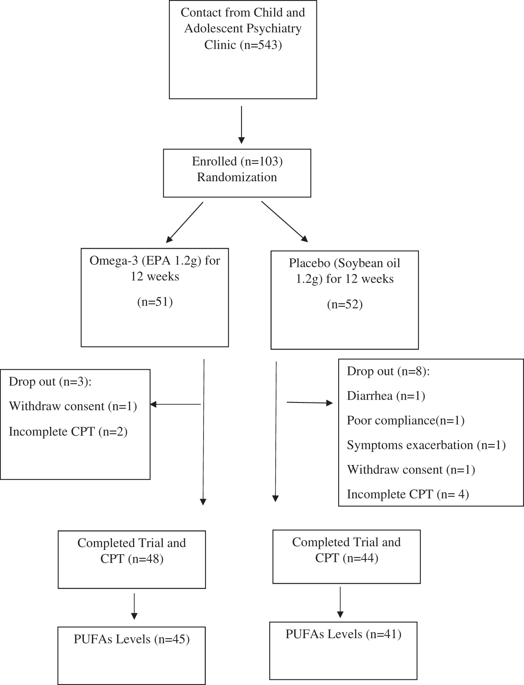当前位置:
X-MOL 学术
›
Transl. Psychiaty
›
论文详情
Our official English website, www.x-mol.net, welcomes your
feedback! (Note: you will need to create a separate account there.)
High-dose eicosapentaenoic acid (EPA) improves attention and vigilance in children and adolescents with attention deficit hyperactivity disorder (ADHD) and low endogenous EPA levels.
Translational Psychiatry ( IF 5.8 ) Pub Date : 2019-11-20 , DOI: 10.1038/s41398-019-0633-0 Jane Pei-Chen Chang , Kuan-Pin Su , Valeria Mondelli , Senthil Kumaran Satyanarayanan , Hui-Ting Yang , Yi-Ju Chiang , Hui-Ting Chen , Carmine M. Pariante
Translational Psychiatry ( IF 5.8 ) Pub Date : 2019-11-20 , DOI: 10.1038/s41398-019-0633-0 Jane Pei-Chen Chang , Kuan-Pin Su , Valeria Mondelli , Senthil Kumaran Satyanarayanan , Hui-Ting Yang , Yi-Ju Chiang , Hui-Ting Chen , Carmine M. Pariante

|
No studies have examined the relationship between endogenous polyunsaturated fatty acids (PUFAs) levels and treatment response to PUFAs. We conducted a 12-week, double-blind, placebo-controlled trial comparing the effects of high-dose eicosapentaenoic acid (EPA, 1.2 g) and placebo on cognitive function (continuous performance test) in n = 92 youth (age 6-18-years-old) with Attention Deficit Hyperactivity Disorder (ADHD). Blood erythrocytes PUFAs were measured before and after treatment, to examine the effects of baseline endogenous EPA levels on treatment response and the effects of EPA treatment on PUFAs levels. Secondary measures included other ADHD symptoms, emotional symptoms, and levels of plasma high-sensitivity c-reactive protein (hs-CRP) and brain-derived neurotrophic factor (BDNF). Overall, EPA group improved more than placebo group on focused attention (variability, Effect size (ES) = 0.38, p = 0.041); moreover, within youth with the lowest baseline endogenous EPA levels, EPA group improved more than placebo group in another measure of focused attention (hit reaction time, HRT, ES = 0.89, p = 0.015) and in vigilance (HRT interstimulus interval changes, HRTISIC, ES = 0.83, p = 0.036). Interestingly, EPA group improved less than placebo group in impulsivity (commission errors), both overall and in youth with the highest baseline EPA levels, who also showed less improvement in other ADHD and emotional symptoms. EPA increased blood erythrocytes EPA by 1.6-fold but not DHA levels, and did not affect hs-CRP and BDNF plasma levels. In conclusion, EPA treatment improves cognitive symptoms in ADHD youth, especially if they have a low baseline endogenous EPA level, while youth with high EPA levels may be negatively affected by this treatment.
中文翻译:

大剂量二十碳五烯酸(EPA)可改善患有注意缺陷多动障碍(ADHD)和内源性EPA水平低的儿童和青少年的注意力和警惕性。
尚无研究检查内源性多不饱和脂肪酸(PUFA)水平与对PUFA的治疗反应之间的关系。我们进行了一项为期12周,双盲,安慰剂对照的试验,比较了n = 92的年轻人(6-18岁)中大剂量二十碳五烯酸(EPA,1.2 g)和安慰剂对认知功能(持续表现测试)的影响岁的儿童)患有注意力缺陷多动障碍(ADHD)。在治疗前后测量血红细胞的PUFA,以检查基线内源性EPA水平对治疗反应的影响以及EPA治疗对PUFAs水平的影响。次要措施包括其他ADHD症状,情绪症状以及血浆高敏c反应蛋白(hs-CRP)和脑源性神经营养因子(BDNF)的水平。全面的,EPA组在集中注意力方面的改善优于安慰剂组(变异性,效应量(ES)= 0.38,p = 0.041);此外,在基线内源性EPA水平最低的年轻人中,EPA组在另一项重点关注的指标(命中反应时间,HRT,ES = 0.89,p = 0.015)和警惕性(HRT刺激间隔改变,HRTISIC)方面比安慰剂组改善更多,ES = 0.83,p = 0.036)。有趣的是,在总体和基线EPA水平最高的年轻人中,EPA组的冲动(犯错)改善均低于安慰剂组,其他ADHD和情绪症状的改善也较安慰剂组少。EPA使血液红细胞EPA增加1.6倍,但不使DHA水平升高,并且不影响hs-CRP和BDNF血浆水平。总之,EPA治疗可改善多动症青年的认知症状,
更新日期:2019-11-20
中文翻译:

大剂量二十碳五烯酸(EPA)可改善患有注意缺陷多动障碍(ADHD)和内源性EPA水平低的儿童和青少年的注意力和警惕性。
尚无研究检查内源性多不饱和脂肪酸(PUFA)水平与对PUFA的治疗反应之间的关系。我们进行了一项为期12周,双盲,安慰剂对照的试验,比较了n = 92的年轻人(6-18岁)中大剂量二十碳五烯酸(EPA,1.2 g)和安慰剂对认知功能(持续表现测试)的影响岁的儿童)患有注意力缺陷多动障碍(ADHD)。在治疗前后测量血红细胞的PUFA,以检查基线内源性EPA水平对治疗反应的影响以及EPA治疗对PUFAs水平的影响。次要措施包括其他ADHD症状,情绪症状以及血浆高敏c反应蛋白(hs-CRP)和脑源性神经营养因子(BDNF)的水平。全面的,EPA组在集中注意力方面的改善优于安慰剂组(变异性,效应量(ES)= 0.38,p = 0.041);此外,在基线内源性EPA水平最低的年轻人中,EPA组在另一项重点关注的指标(命中反应时间,HRT,ES = 0.89,p = 0.015)和警惕性(HRT刺激间隔改变,HRTISIC)方面比安慰剂组改善更多,ES = 0.83,p = 0.036)。有趣的是,在总体和基线EPA水平最高的年轻人中,EPA组的冲动(犯错)改善均低于安慰剂组,其他ADHD和情绪症状的改善也较安慰剂组少。EPA使血液红细胞EPA增加1.6倍,但不使DHA水平升高,并且不影响hs-CRP和BDNF血浆水平。总之,EPA治疗可改善多动症青年的认知症状,










































 京公网安备 11010802027423号
京公网安备 11010802027423号